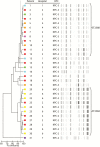Colistin Resistance in Carbapenem-Resistant Klebsiella pneumoniae: Laboratory Detection and Impact on Mortality
- PMID: 27940944
- PMCID: PMC5850634
- DOI: 10.1093/cid/ciw805
Colistin Resistance in Carbapenem-Resistant Klebsiella pneumoniae: Laboratory Detection and Impact on Mortality
Abstract
Background: Polymyxins including colistin are an important "last-line" treatment for infections caused by carbapenem-resistant Klebsiella pneumoniae (CRKp). Increasing use of colistin has led to resistance to this cationic antimicrobial peptide.
Methods: A cohort nested within the Consortium on Resistance against Carbapenems in Klebsiella pneumoniae (CRACKLE) was constructed of patients with infection, or colonization with CRKp isolates tested for colistin susceptibility during the study period of December, 2011 to October, 2014. Reference colistin resistance determination as performed by broth macrodilution was compared to results from clinical microbiology laboratories (Etest) and to polymyxin resistance testing. Each patient was included once, at the time of their first colistin-tested CRKp positive culture. Time to 30-day in-hospital all-cause mortality was evaluated by Kaplan-Meier curves and Cox proportional hazard modeling.
Results: In 246 patients with CRKp, 13% possessed ColR CRKp. ColR was underestimated by Etest (very major error rate = 35%, major error rate = 0.4%). A variety of rep-PCR strain types were encountered in both the ColS and the ColR groups. Carbapenem resistance was mediated primarily by blaKPC-2 (46%) and blaKPC-3 (50%). ColR was associated with increased hazard for in-hospital mortality (aHR 3.48; 95% confidence interval, 1.73-6.57; P < .001). The plasmid-associated ColR genes, mcr-1 and mcr-2 were not detected in any of the ColR CRKp.
Conclusions: In this cohort, 13% of patients with CRKp presented with ColR CRKp. The apparent polyclonal nature of the isolates suggests de novo emergence of ColR in this cohort as the primary factor driving ColR. Importantly, mortality was increased in patients with ColR isolates.
Keywords: Klebsiella pneumoniae; carbapenem-resistant Enterobacteriaceae; colistin; mortality; ST258.
© The Author 2016. Published by Oxford University Press for the Infectious Diseases Society of America. All rights reserved. For permissions, e-mail: journals.permissions@oup.com
Figures




Comment in
-
Reply to Macesic et al.Clin Infect Dis. 2017 Aug 15;65(4):703-704. doi: 10.1093/cid/cix394. Clin Infect Dis. 2017. PMID: 29017266 Free PMC article. No abstract available.
-
Colistin Resistance in Carbapenem-Resistant Klebsiella pneumoniae: De Novo or Drug Exposure?Clin Infect Dis. 2017 Aug 15;65(4):702-703. doi: 10.1093/cid/cix393. Clin Infect Dis. 2017. PMID: 29017267 Free PMC article. No abstract available.
References
-
- Tumbarello M, Viale P, Viscoli C, et al. Predictors of mortality in bloodstream infections caused by Klebsiella pneumoniae carbapenemase-producing K. pneumoniae: importance of combination therapy. Clin Infect Dis 2012; 55:943–50. - PubMed
MeSH terms
Substances
Grants and funding
LinkOut - more resources
Full Text Sources
Other Literature Sources
Medical

